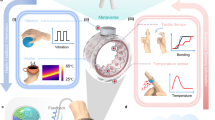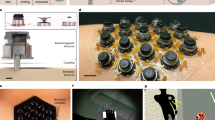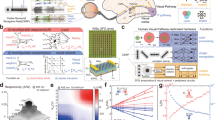Abstract
Artificial intelligence-powered wearable electronic systems offer promising solutions for non-invasive visual assistance. However, state-of-the-art systems have not sufficiently considered human adaptation, resulting in a low adoption rate among blind people. Here we present a human-centred, multimodal wearable system that advances usability by blending software and hardware innovations. For software, we customize the artificial intelligence algorithm to match the requirements of application scenario and human behaviours. For hardware, we improve the wearability by developing stretchable sensory-motor artificial skins to complement the audio feedback and visual tasks. Self-powered triboelectric smart insoles align real users with virtual avatars, supporting effective training in carefully designed scenarios. The harmonious corporation of visual, audio and haptic senses enables significant improvements in navigation and postnavigation tasks, which are experimentally evidenced by humanoid robots and participants with visual impairment in both virtual and real environments. Postexperiment surveys highlight the system’s reliable functionality and high usability. This research paves the way for user-friendly visual assistance systems, offering alternative avenues to enhance the quality of life for people with visual impairment.
This is a preview of subscription content, access via your institution
Access options
Access Nature and 54 other Nature Portfolio journals
Get Nature+, our best-value online-access subscription
$32.99 / 30 days
cancel any time
Subscribe to this journal
Receive 12 digital issues and online access to articles
$119.00 per year
only $9.92 per issue
Buy this article
- Purchase on SpringerLink
- Instant access to full article PDF
Prices may be subject to local taxes which are calculated during checkout






Similar content being viewed by others
Data availability
All the data required to assess the conclusions of the article are available via Figshare at https://doi.org/10.6084/m9.figshare.26103583 (ref. 39) and are available for reuse for ethical and scientific purposes.
Code availability
The exemplary scripts for data processing and analysis for this study are available in the GitHub repository at https://github.com/JianTang2000/wearableSystem (ref. 40).
References
Roska, B. & Sahel, J. A. Restoring vision. Nature 557, 359–367 (2018).
Maidenbaum, S., Abboud, S. & Amedi, A. Sensory substitution: closing the gap between basic research and widespread practical visual rehabilitation. Neurosci. Biobehav. Rev. 41, 3–15 (2014).
Tapu, R., Mocanu, B. & Zaharia, T. Wearable assistive devices for visually impaired: a state of the art survey. Pattern Recogn. Lett. 137, 37–52 (2020).
Herskovitz, J. et al. Hacking, switching, combining: understanding and supporting DIY assistive technology design by blind people. In Proc. 2023 CHI Conference on Human Factors in Computing Systems (eds Albrecht, S. et al.) 1–17 (ACM, 2023).
Shah, D., Osiński, B. & Levine, S. Lm-nav: robotic navigation with large pre-trained models of language, vision, and action. In Proc. 2024 Conference on Robot Learning (eds Marc, T. et al.) 492–504 (PMLR, 2024).
Wu, W. et al. Vision-language navigation: a survey and taxonomy. Neural Comput. Appl. 36, 3291–3316 (2024).
Spoendlin, H. & Schrott, A. Analysis of the human auditory nerve. Hear. Res. 43, 25–38 (1989).
Bach‐y‐Rita, P. Tactile sensory substitution studies. Ann. N. Y. Acad. Sci. 1013, 83–91 (2004).
Nguyen, T. H. et al. A wearable assistive device for the blind using tongue-placed electrotactile display: design and verification. In Proc. 2013 International Conference on Control, Automation and Information Sciences (eds Jin, B. et al.) 42–47 (IEEE, 2013).
Huang, Y. et al. A skin-integrated multimodal haptic interface for immersive tactile feedback. Nat. Electron. 6, 1020–1031 (2023).
Guo, H. et al. A highly sensitive, self-powered triboelectric auditory sensor for social robotics and hearing aids. Sci. Robot. 3, eaat2516 (2018).
Liu, Y. et al. Soft, miniaturized, wireless olfactory interface for virtual reality. Nat. Commun. 14, 2297 (2023).
Hoffmann, R. et al. Evaluation of an audio-haptic sensory substitution device for enhancing spatial awareness for the visually impaired. Optom. Vis. Sci. 95, 757–765 (2018).
Li, G., Xu, J., Li, Z., Chen, C. & Kan, Z. Sensing and navigation of wearable assistance cognitive systems for the visually impaired. IEEE Trans. Cogn. Dev. Syst. 15, 122–133 (2022).
Xu, C. et al. A physicochemical-sensing electronic skin for stress response monitoring. Nat. Electron. 7, 168–179 (2024).
Yang, Q. et al. Mixed-modality speech recognition and interaction using a wearable artificial throat. Nat. Mach. Intell. 5, 169–180 (2023).
Gu, L. et al. A biomimetic eye with a hemispherical perovskite nanowire array retina. Nature 581, 278–282 (2020).
Yao, K. et al. Encoding of tactile information in hand via skin-integrated wireless haptic interface. Nat. Mach. Intell. 4, 893–903 (2022).
Jocher, C. et al. Ultralytics yolov8. GitHub https://github.com/ultralytics/ultralytics (2023).
Krausz, N. E., Lenzi, T. & Hargrove, L. J. Depth sensing for improved control of lower limb prosthesis. IEEE Trans. Biomed. Eng. 62, 2576–2587 (2015).
González, J. & Yu, W. Multichannel audio aided dynamical perception for prosthetic hand biofeedback. In Proc. 2009 IEEE International Conference on Rehabilitation Robotics (eds Kiyoshi, N. et al.) 240–245 (IEEE, 2009).
George, J. A. et al. Biomimetic sensory feedback through peripheral nerve stimulation improves dexterous use of a bionic hand. Sci. Robot. 4, eaax2352 (2019).
Meijer, P. B. An experimental system for auditory image representations. IEEE Trans. Biomed. Eng. 39, 112–121 (1992).
Levy-Tzedek, S., Hanassy, S., Abboud, S., Maidenbaum, S. & Amedi, A. Fast, accurate reaching movements with a visual-to-auditory sensory substitution device. Restor. Neurol. Neurosci. 30, 313–323 (2012).
Yang, Y. et al. Breathable electronic skins for daily physiological signal monitoring. Nano-Micro Lett. 14, 161 (2022).
Chortos, A., Liu, J. & Bao, Z. Pursuing prosthetic electronic skin. Nat. Mater. 15, 937–950 (2016).
Yu, Y. et al. All-printed soft human-machine interface for robotic physicochemical sensing. Sci. Robot. 7, eabn0495 (2022).
Yu, X. et al. Skin-integrated wireless haptic interfaces for virtual and augmented reality. Nature 575, 473–479 (2019).
Sanes, J. N. & Donoghue, J. P. Plasticity and primary motor cortex. Annu. Rev. Neurosci. 23, 393–415 (2000).
Susal, J., Krauss, K., Tsingos, N. & Altman, M. Immersive audio for VR. In Proc. 2016 AES International Conference on Audio for Virtual and Augmented Reality (eds Andres, M. et al.) 99–124 (Audio Engineering Society, 2016).
Zhao, Y. et al. Enabling independent navigation for visually impaired people through a wearable vision-based feedback system. In Proc. 2018 CHI Conference on Human Factors in Computing Systems (eds Regan, M. et al.) 1–14 (ACM, 2018).
Slade, P., Tambe, A. & Kochenderfer, M. J. Multimodal sensing and intuitive steering assistance improve navigation and mobility for people with impaired vision. Sci. Robot. 6, eabg6594 (2021).
Jordan, P. W., Thomas, B., McClelland, I. L. & Weerdmeester, B. Usability Evaluation in Industry (CRC, 1996).
Sauro, J. A Guide to the System Usability Scale: Background, Benchmarks & Best Practices (Measuring Usability LLC, 2011).
Country, M. W. Retinal metabolism: a comparative look at energetics in the retina. Brain Res. 1672, 50–57 (2017).
Liao, F. et al. Bioinspired in-sensor visual adaptation for accurate perception. Nat. Electron. 5, 84–91 (2022).
Park, J. et al. Avian eye-inspired perovskite artificial vision system for foveated and multispectral imaging. Sci. Robot. 9, eadk6903 (2024).
Zhang, Z. et al. All-in-one two-dimensional retinomorphic hardware device for motion detection and recognition. Nat. Nanotechnol. 17, 27–32 (2022).
Jian, T. et al. Human-centered design and fabrication of a wearable multimodal visual assistance system. FigShare https://doi.org/10.6084/m9.figshare.26103583 (2025).
Jian, T. et al. Human-centered design and fabrication of a wearable multimodal visual assistance system. Zenodo https://doi.org/10.5281/zenodo.14752720 (2025).
Acknowledgements
This work was funded by STI 2030—Major Projects (grant no. 2022ZD0210000), National Science Foundation China grant (no. 62274110) and Shanghai Rising-Star Program (grant no. 21QA1404000). The individuals involved in the 2022ZD0210000 project include L.G. and B.Y., the 62274110 project includes L.G. and the 21QA1404000 project includes L.G. We sincerely thank all the participants who generously volunteered their time, provided valuable feedback and contributed to the study.
Author information
Authors and Affiliations
Contributions
L.G. and J.T. were responsible for the system design. J.T., Y.Z., G.J., L.X. and W.R. conducted the experiments. J.T., L.G., H.B. and Q.G. developed the AI algorithm, B.Y., J.Z, X.W. and Z.F. assisted the data collection and analysis. All authors participated in manuscript preparation.
Corresponding author
Ethics declarations
Competing interests
The authors declare no competing interests.
Peer review
Peer review information
Nature Machine Intelligence thanks Wei Gao and Xinge Yu for their contribution to the peer review of this work.
Additional information
Publisher’s note Springer Nature remains neutral with regard to jurisdictional claims in published maps and institutional affiliations.
Supplementary information
Supplementary Information
Supplementary Figs. 1–28, Discussion and Tables 1 and 2.
Supplementary Video 1
Humanoid navigates to the target.
Supplementary Video 2
Humanoid navigates to the target with obstacle avoidance.
Supplementary Video 3
Artificial skins assist dynamic obstacle avoidance.
Supplementary Video 4
Artificial skins assist postnavigation task.
Supplementary Video 5
VR training.
Supplementary Video 6
A representative VIP navigates through a maze under guidance of the system.
Supplementary Video 7
Real-world testing. A VIP navigates through a cluttered conference room.
Supplementary Video 8
Real-world testing. A VIP navigates through an outdoor dynamic environment.
Supplementary Video 9
Real-world testing. A VIP navigates through a narrow corridor.
Supplementary Video 10
Real-world testing. A VIP completes a comprehensive task emulating real-world challenge.
Rights and permissions
Springer Nature or its licensor (e.g. a society or other partner) holds exclusive rights to this article under a publishing agreement with the author(s) or other rightsholder(s); author self-archiving of the accepted manuscript version of this article is solely governed by the terms of such publishing agreement and applicable law.
About this article
Cite this article
Tang, J., Zhu, Y., Jiang, G. et al. Human-centred design and fabrication of a wearable multimodal visual assistance system. Nat Mach Intell 7, 627–638 (2025). https://doi.org/10.1038/s42256-025-01018-6
Received:
Accepted:
Published:
Issue date:
DOI: https://doi.org/10.1038/s42256-025-01018-6
This article is cited by
-
AI-boosted cameras help blind people to navigate
Nature (2025)



